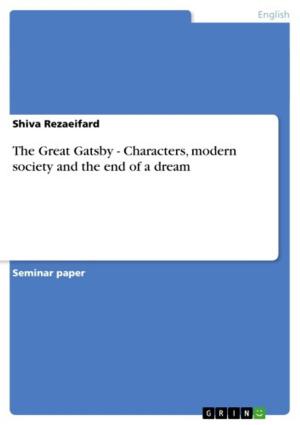The Americans' and Asians' Ideas about Each Other in T.C. Boyle's 'East is East'
Nonfiction, Entertainment, Drama, Anthologies| Author: | Melissa Naase | ISBN: | 9783640976607 |
| Publisher: | GRIN Publishing | Publication: | August 4, 2011 |
| Imprint: | GRIN Publishing | Language: | English |
| Author: | Melissa Naase |
| ISBN: | 9783640976607 |
| Publisher: | GRIN Publishing |
| Publication: | August 4, 2011 |
| Imprint: | GRIN Publishing |
| Language: | English |
Seminar paper from the year 2011 in the subject American Studies - Literature, grade: 2,0, University of Paderborn (Anglistik und Amerikanistik), course: T. C. Boyle, language: English, abstract: 1 Introduction This paper is about the stereotypes that Asians and Americans have of each other. Therefore quotations from Boyle's book: 'East is East' are listed. Though it was not part of the presentation, you will also find the quotations on the Asians' ideas about Americans here in order to give a statement on each nation's representative's awareness on those matters. After that there is a chapter on coping with prejudices, and the terms of assimilation and acculturation are defined. Last there is an overview of our presentation explaining the different phases, their contents and aims. The transcript of the news-show is given and a short reflection on the presentation and working on this topic can be found. Before you read on, I would like to explain three terms here which are used simultaneously during this paper. Often it is not possible to distinguish between a cliché, a stereotype or a prejudice because the definitions of those terms are very similar and the choice of the right term depends on everyone's individual experiences with regard to the certain subject. Nevertheless I want to show that there are certain differences, by giving the definitions here: •Cliché: A phrase or opinion that is overused and shows a lack of original thought. •Stereotype: An image or idea of a particular type of person or thing that has become fixed through being widely held. •Prejudice: Pre-assumption, pre-conceived opinion that is not based on reason or actual experience. 2 Quotes: The Asians' Ideas about Americans Actually this chapter on the Asian's ideas about Americans was not part of our presentation. But when reading the book I marked all of those in order to compare the stereotypes both nations have of each other. 2.1 Words used for Americans in the Book •long nose •hakujin •butter stinker •keto (p.267) •for Saxby: big hairy boifurendo 2.2 Hiro's Grandma describing his Father p.15 ..(he always was dirty and hairy, no matter the version)... 2.3 Hiro's View of Americans- Adopted from Films and Books p.17f But if Japanes were a pure race, intolerant of misgenation to the point of fanaticism, the Americans, he knew, were a polyglot tribe, mutts and mulattos and worse- or better, depending on your point of view. In America you could be one part Negro, two parts Serbo-Croatian and three parts Eskimo and walk down the street with your head held high. I
Seminar paper from the year 2011 in the subject American Studies - Literature, grade: 2,0, University of Paderborn (Anglistik und Amerikanistik), course: T. C. Boyle, language: English, abstract: 1 Introduction This paper is about the stereotypes that Asians and Americans have of each other. Therefore quotations from Boyle's book: 'East is East' are listed. Though it was not part of the presentation, you will also find the quotations on the Asians' ideas about Americans here in order to give a statement on each nation's representative's awareness on those matters. After that there is a chapter on coping with prejudices, and the terms of assimilation and acculturation are defined. Last there is an overview of our presentation explaining the different phases, their contents and aims. The transcript of the news-show is given and a short reflection on the presentation and working on this topic can be found. Before you read on, I would like to explain three terms here which are used simultaneously during this paper. Often it is not possible to distinguish between a cliché, a stereotype or a prejudice because the definitions of those terms are very similar and the choice of the right term depends on everyone's individual experiences with regard to the certain subject. Nevertheless I want to show that there are certain differences, by giving the definitions here: •Cliché: A phrase or opinion that is overused and shows a lack of original thought. •Stereotype: An image or idea of a particular type of person or thing that has become fixed through being widely held. •Prejudice: Pre-assumption, pre-conceived opinion that is not based on reason or actual experience. 2 Quotes: The Asians' Ideas about Americans Actually this chapter on the Asian's ideas about Americans was not part of our presentation. But when reading the book I marked all of those in order to compare the stereotypes both nations have of each other. 2.1 Words used for Americans in the Book •long nose •hakujin •butter stinker •keto (p.267) •for Saxby: big hairy boifurendo 2.2 Hiro's Grandma describing his Father p.15 ..(he always was dirty and hairy, no matter the version)... 2.3 Hiro's View of Americans- Adopted from Films and Books p.17f But if Japanes were a pure race, intolerant of misgenation to the point of fanaticism, the Americans, he knew, were a polyglot tribe, mutts and mulattos and worse- or better, depending on your point of view. In America you could be one part Negro, two parts Serbo-Croatian and three parts Eskimo and walk down the street with your head held high. I















